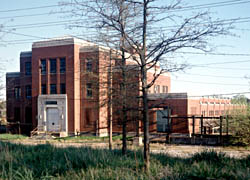|
||||||||||||||||||||||||||||||||||||||||||||||||||||||||||||||||||
|
||||||||||||||||||||||||||||||||||||||||||||||||||||||||||||||||||
The Raleigh Water Works and E. B. Bain Water Treatment Plant complex was built for a single, basic task--to supply Raleigh's water needs. Yet the complex also provides a ready gauge of the city's historical growth and community pride. In 1938, Raleigh was faced with a choice. It could reduce growing demand for city water by limiting access from unincorporated areas, or it could build a new plant. City leaders looked into the future and decided to build. The city obtained federal public works funding and floated a bond issue to get the $700,000 needed to build a new plant, and work started in mid-1939. Dedicated in mid-1940, the plant was named after longtime city water superintendent Ernest Battle Bain. While strictly utilitarian in concept, the Bain plant, as built, is perhaps the foremost Art Deco style building in Raleigh, displaying a surprising level of architectural detail. The brick building includes a full basement, and parts are four stories high. The two-story entrance lobby features a mezzanine circling the upper level and soaring stairways rising up both sides. The stairs have ornamental wrought and cast-iron railings and oak handrails, and the lobby ceiling is adorned with ornamented plaster beams. The original light fixtures remain, as does the original red quarry floor tile. The operations floors, located in a 13-bay, two-and-a-half story wing, flank an extended arcade of molded plaster arches, with pilasters marking the bays. Above both sides of the arcade are square clerestory windows.
By the 1990s, however, the building was reduced to being a storage facility. A new era began in 1999, when the Raleigh City Council accepted an offer from Capital Area Preservation, Inc. and Historic Preservation Advisors, LLC to rehabilitate and manage the property. Sold to Empire Properties in 2006, the site remains in pre-development. The E B. Bain Water Treatment Plant is a designated Raleigh Historic Landmark. The Raleigh Water Works and E. B. Bain Water Treatment Plant complex is located at 1810 Fayetteville Rd. The facility is closed pending rehabilitation work. |
||||||||||||||||||||||||||||||||||||||||||||||||||||||||||||||||||
Raleigh Home | List of Sites | Maps| Learn More | Itineraries | NR Home | Next Site
Essays: Early History | African American History| Suburbanization| Modernism | Preservation
Comments or Questions
JPJ/RQ/SB
![[graphic] Raleigh: A Capital City: A National Register of Historic Places Travel Itinerary [graphic] Raleigh: A Capital City: A National Register of Historic Places Travel Itinerary](graphics/header6_r1_c1.gif)
![[graphic] Property title [graphic] Property title](graphics/ebb.gif)

![[photo] [photo]](BUILDINGS/ebb2.jpg) Raleigh Water Works
Raleigh Water Works